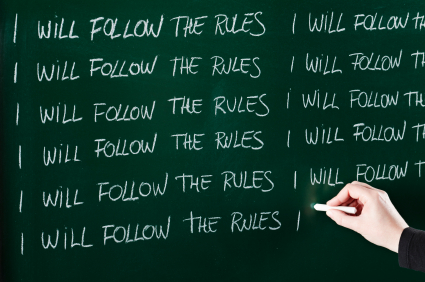MLA, APA, & CMS: How to Properly Format Your Papers
Knowing the Styles and When to Use Them
In academic writing, how you present your information (technically) is often seen as important as the ideas you are putting forth. Proper citing, quoting and referencing of source material allows you to convey your breadth of research in a language commonly shared by others in your discipline. Giving others a chance to review and compare your work under these established guidelines enables your instructors to better see the work on its own merits, opposed to getting sidetracked by technical inefficiencies.

You MUST follow the rules like every other student: this is not an area where you want to stand out for doing things your own way. Writing for any academic purpose carries with it certain expectations and formatting consistencies, and a failure to properly understand how or why you cite your sources in a specific way can have negative effects on your written projects and communications.
The Big Three: APA, MLA, and CMS
There are three main "Schools of Style" used to properly format an academic paper, referred to as APA, MLA, or CMS.
- APA style: These are the official guidelines put forth by the American Psychological Association, now in its sixth edition. This is the preference of the social sciences, so if you are studying sociology, psychology, medicine, or social work you are going to know APA style.
- MLA style: The Modern Language Association provides guidelines you will be familiar with if you are focused on the Humanities: so artists, English majors, and theatre students will know MLA as they have used this style now for more than half a century.
- CMS style: These are the style guidelines put forth in the Chicago Manual of Style, now in its 16th edition. CMS style is predominantly seen in the humanities, particularly with literature students and those who study advanced segments of history and/or the arts.
While these formatting methods will share many characteristics such as margins and spacing, how they attribute references to source materials is the main differentiator. For example, APA lists "references" while MLA calls the same thing "works cited" - a small but important distinction that might actually affect your grade.
Typically, you are going to use one style for most of your classes and communications, but there is certainly the possibility that you'll need to know how to use any one of these three common styles. The good news is it is not hard to get up-to-speed on any one of them and use them properly.
Get the Latest Updates
Regardless of which style you are using, it is imperative to get the most recent version of the guidelines to ensure your paper is as accurate as it can be. Each of the sources have updated their guidelines multiple times over the years, so working with the current standards is goal one.
- APA style guidelines: http://www.apastyle.org
- MLA style guidelines: http://www.mla.org/style
- CMS style guidelines: http://www.chicagomanualofstyle.org/
APA and MLA are the most common styles to use, but CMS is not unheard of - just not as common for undergrads. CMS is commonly used in traditional book publishing and academic publishing situations, so if you are doing post-graduate writing, it is good to know.
The main thing that seems to be changing in the rules for all of them is about the proper attribution of web-related sources, so you are going to want to re-check that you are working from the most recent versions of whichever style guide you need.
Beware the Pitfalls
The common mistakes being made in properly styling citations and references might be as simple as not downloading the most recent updates; however, it may also be a case where students are simply not understanding how to infuse referencing properly.
Common APA Mistakes
"One of the most common mistakes I see," stated Professor John Long, who has studied social science and has taught health care administration and career development at a college level for various universities for more than five years, "are errors in properly citing web references." Professor Long and his students - being in the social sciences - have never used anything except APA style. He is currently working on his own education specialist degree (Ed.S.) now at U of Missouri, which is half way to the Doctor of Education (Ed.D.) degree.
He continues: "While some common APA formatting errors may be issues due to changes in updated guidelines (APA 5 vs. APA 6), there are other, perhaps more common instances where a student fails to properly reference the source materials within writing assignments. This is particularly true when citing content from the Internet. Understanding how to properly reference and cite source materials adds power to any student paper, because the papers can be used to show a proper understanding and blending of source ideas - a critical concept in higher learning."
"Some of the changes to the guidelines seem very dubious and meticulous," he continues, "but standards are there so an evaluator can assess the weight of the material without bias. Many of my students might complain about it, but the ones that succeed are the ones who are actively trying to use citing resources to their own argument's advantage."
Common MLA Mistakes
APA students are not the only ones who have common mistakes in formatting - as evidenced by the following insight offered from Dr. Margaret Walters of Kennesaw State University, where she and her students have used primarily MLA guidelines in their writing, editing and literature classes. Dr. Walters has taught a variety of undergraduate and graduate level writing courses at Kennesaw State University for over 15 years.
Dr. Walters said, "The most common problems I see with MLA style occur in the writing, meaning the text itself, not the bibliography or Works Cited...though there are often some problems to address there, too. In the text, the most common problems are:
- putting a period before and sometimes after the parenthetical citation, as in: ".... and this point is made early on." (Smith 127).
- placing the closing quotation mark after the citation in parenthesis instead of after the quote: " .... and this point is made early on (Smith 127)".
- placing quotation marks inside commas and periods instead of after them: Smith tells us that among the most important rules are the ones regarding use of commas", yet he does not explain how this happens". (127) [those writing British English use the opposite rule--quotation marks inside end punctuation]."
Dr. Walters continued: "In the Works Cited, the most common MLA-related problems are:
- not alphabetizing (even though this is the easiest rule to follow)
- mixing up MLA and APA style; e.g. using initials for first names when MLA says use full first names and middle initials
- leaving off the place of publication - it should be New York: Penguin, 2009 but will instead say Penguin, 2009
- not knowing rules for using quotations marks or when to underline/italicize
"Students get it right most of the time," Dr. Walters states. "I think the underlying problem is an unwillingness to use the style sheets, handouts, or even the MLA handbook. If they use the resources offered, most students are not going to struggle to meet the guidelines."
Get More Help
Both Dr. Walters and Professor Long advise students to use strong and verifiable resources to make your formatting job easier. Both instructors advise checking out the OWL (Online Writing Lab) Resources offered by Purdue in addition to the links to the sites listed above.
The writing center at your own university may hold lots of great information and people to help you understand what to do in each situation you face. Not every situation calls for the same style guide, so checking with the experts on your campus is always a smart idea.
For a quick reference, you can also use the handy visual aids created by Capital Community College on MLA and APA styled papers: (http://www.ccc.commnet.edu/library/citing.htm) or look at the MLA vs. APA comparison chart created by the University Writing Center at Appalachian State University.
The Bottom Line
The reality is, depending on your discipline, there may be only one type of style that you need to use, ever. However, this is not saying the rules for how to properly cite resources and references is not going to continue to change and evolve over time. You will be held responsible for being current.
As a student or in post-college academic writing, you want your work to shine and to always show your best efforts. This means checking on the rules to properly style and format your papers. Use the links and information above to help ensure you are forever properly dotting your I's and crossing your T's according to the latest and greatest rules.
Browse Scholarships
Resources
- Homework Helper
- Writing an Essay
- Selecting an Essay Topic
- MLA, APA & CMS Formatting
- Information Requests
- College Books
- Scholarship Scams
- Management Services
- Tax Credits
- Thank You Letters
- Spam-Free Searching
- Tuition Reimbursement
- College Saving Tips
